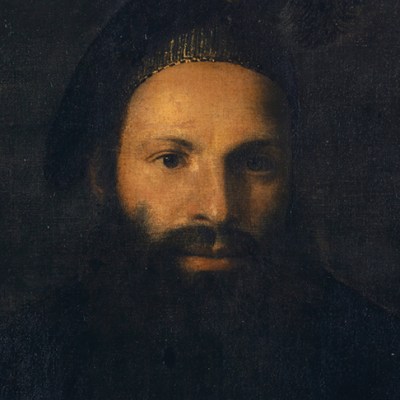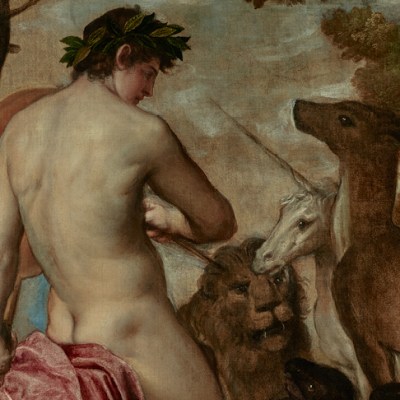In the spring of 1806 polite society in London was fascinated by the opening of the Stafford Gallery at Cleveland House in St James’s, the home of the Marquess and Marchioness of Stafford. It provided a splendid backdrop to their renowned collection of paintings. This was 18 years before the National Gallery welcomed its first visitors, and those who admired the Stafford collection, including the Prince of Wales, were able to see nearly 300 paintings, including seminal works by Titian and Raphael.
 Some of these stellar pictures had formed part of the collection of the dukes of Orléans, displayed in the 18th century at the Palais-Royal in Paris. They were supplemented by other judicious acquisitions, which carried the collection into the realms of Italian baroque and Dutch 17th-century painting, and brought it up to date with the inclusion of Turner, alongside other luminaries of the British school. There was no intention to create a comprehensive survey of European art in the sense that we would understand it today, but the quality and broad spectrum of works on display were at the time unique in Britain (with the exception of the Royal Collection, which was widely distributed between palaces) and had a profound impact. The Stafford Gallery closed in 1830, when the collection was divided between the marquess’s two sons. The inspiration it provided endured into the 20th century, however, as the paintings formed the basis of other important displays in London – at the Sutherland Gallery (Stafford House, Green Park) and the Bridgewater Gallery (Bridgewater House, as Cleveland House came to be known).
Some of these stellar pictures had formed part of the collection of the dukes of Orléans, displayed in the 18th century at the Palais-Royal in Paris. They were supplemented by other judicious acquisitions, which carried the collection into the realms of Italian baroque and Dutch 17th-century painting, and brought it up to date with the inclusion of Turner, alongside other luminaries of the British school. There was no intention to create a comprehensive survey of European art in the sense that we would understand it today, but the quality and broad spectrum of works on display were at the time unique in Britain (with the exception of the Royal Collection, which was widely distributed between palaces) and had a profound impact. The Stafford Gallery closed in 1830, when the collection was divided between the marquess’s two sons. The inspiration it provided endured into the 20th century, however, as the paintings formed the basis of other important displays in London – at the Sutherland Gallery (Stafford House, Green Park) and the Bridgewater Gallery (Bridgewater House, as Cleveland House came to be known).
As this brief description shows, the story of the formation of the collection and its display and dispersal is complex, but it is navigated here with great skill, insight and engagement by Peter Humfrey, in what is somewhat surprisingly the first full-length survey of this crucial episode in the history of British taste.
The collection of George Leveson-Gower, 2nd Marquess of Stafford (1758–1833) consisted of major works inherited from his uncle, the Duke of Bridgewater, and Continental and British paintings that Stafford acquired. Humfrey provides an important survey of the Duke of Bridgewater’s family background, his Grand Tour and accumulation of wealth, as well as the formulation of his interests as a collector, including the Orléans purchase in 1799, in the wake of the French Revolution, and his subsequent enthusiasm for Dutch art. His intriguing connection with Turner also forms part of this story. Dutch Boats in a Gale (‘The Bridgewater Sea Piece’) was commissioned as a pendant to Willem van de Velde the Younger’s Ships on a Stormy Sea. Bridgewater paid Turner 250 guineas for the work, and it would be pleasing to know more about the relationship between the two men, but on this front the sources are silent. The duke is, however, more clearly defined than ever before in this account of him as a thoughtful collector rather than a mere opportunist. Little surviving evidence shows how his paintings were displayed, although their arrangement can be glimpsed through a fascinating sketch in the painter Joseph Farington’s diary.
Minerva Protects Pax from Mars (‘Peace and War’) (1629–30), Peter Paul Rubens. National Gallery, London

The Marquess of Stafford’s collection was chiefly formed of British art, exemplified by Hogarth and Wilkie, and European works including Moroni, Van Dyck, Ter Borch and Antoine Le Nain, which complemented his inheritance from his uncle most effectively. The greatest of all of his acquisitions was undoubtedly Rubens’ Minerva Protects Pax from Mars (‘Peace and War’), which he bought in 1803 for £3,000, and which was later presented to the National Gallery.
The impressive neoclassical gallery that housed all these treasures, distributed through a sequence of 11 top-lit rooms, was designed by the architect Charles Heathcote Tatham. The gallery was in essence a grand, private townhouse that gave context to an aristocratic collection. However, through a combination of a degree of public access (Wednesday afternoons in May, June and July) and the numerous publications created about it, the collection it housed became a focus of wider public discourse. The most splendid of these books was William Young Ottley’s four volumes of engravings (1818), which feature detailed elevations that show precisely how the paintings in the collection were displayed. A particularly interesting aspect of Humfrey’s research is the illustrated reconstructions based on these hang plans. From these we get a clear sense, for example, of how the Titians were hung in the Dining Room, and how Raphael’s Holy Family with a Palm Tree was used as a key focus in the large, so-called New Gallery. The Raphaels were singled out by William Hazlitt in his 1823 appreciation of the collection for especial praise. By contrast with the specifics of Young Ottley’s engravings and Hazlitt’s analysis, another contemporary image evokes in a highly inventive and generalised manner the now-lost grandeur of the Stafford Gallery: Pieter Christoffel Wonder’s fascinating painting Patrons and Lovers of Art (1826/30), which features a number of works in the collection. Humfrey’s study considers this fantasy in detail, and also includes valuable appendices which list the paintings in the Bridgewater and Stafford collections, as well as later additions.
The legacy of this rich history of collecting and display has been far-reaching, and immensely beneficial. It contributed (along with the establishment in 1805 of the British Institution and in 1814 of Dulwich Picture Gallery) to the growing clamour for a National Gallery, which was eventually realised in 1824. The later Sutherland and Bridgewater Galleries, as Humfrey shows, also played a key, wider role in giving access to this extraordinary inheritance of paintings to Victorian visitors.
Many of the major paintings seen in the Stafford Gallery in the early 19th century have found their way into public collections and have played a part in transforming the British appreciation of Old Masters. Perhaps the greatest of all are the two Titians from his Poesie cycle created for Philip II, which were jointly acquired in 2009–12 by the National Galleries in Edinburgh and London.
The Stafford Gallery: The Greatest Art Collection of Regency London by Peter Humfrey is published by Unicorn Press.
From the January 2020 issue of Apollo. Preview and subscribe here.



